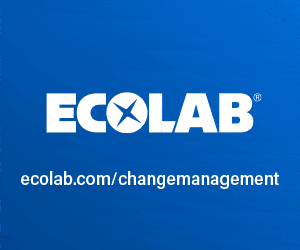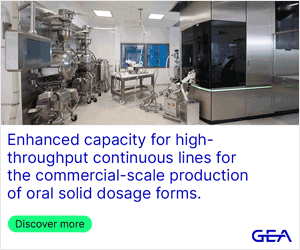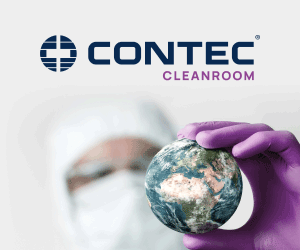Due to the complexity involved in handling cytotoxic and cytostatic substances, manufacturers of high potency active pharmaceutical ingredients (HAPIs) and the resultant drug products are faced with more onerous manufacturing challenges than the regulatory Good Manufacturing Practice (GMP) rules and guidelines applicable to sterile drug manufacture.
High potency compounds are classified according to their potential to cause harm at low doses, at or near the therapeutic dose or lower. A traditional limit of 1/1000th of the low clinical dose has been in use, but note – this is not a health-based measure. This limit may be insufficient or indeed be excessive in setting protection limits.
The European Medicines Agency (EMA) has released a new draft guideline on setting health-based exposure limits. One definition for a high potency molecule is based on health effects: an occupational exposure limit (OEL) set at or below 10 micrograms per cubic metre of air (10µg/m3) as an eight-hour time weighted average (8hr TWA).
Manufacturing challenges: Due consideration must be given to the safety and protection of operators from exposure to high potency compounds through inhalation, ingestion, dermal and other mechanical routes. The end-to-end activities supporting the supply chain, from pre-receipt of the incoming API, through the subsequent stages of storage, processing, in-process testing, formulation and filling, laboratory analysis and stability testing to final shipment of drug product, must also be scrutinised to ensure adequate control measures are in place for these compounds.
From a regulatory standpoint, GMP requires dedicated containment facilities and effective standard operating procedures to control satisfactorily processing of such compounds and thereby reduce the risk of cross contamination not only of other drug products but also of equipment and utility services. Systems must be in place to protect the integrity of adjacent manufacturing areas and their surrounding environment. In addition, containment must be provided at appropriate levels for managing the collection, storage and subsequent disposal of process waste and effluent, and defining and training effective emergency response procedures.
Satisfactory handling of potent materials can be achieved by using a risk-based assessment of these challenges and implementing adequate control measures.
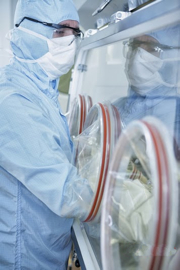
The most effective approach currently deployed to achieve the required degree of containment for HAPI is through the use of partial or totally enclosed barrier systems
Copyright SCM Pharma
Many contract manufacturer organisations (CMO) use a scientific approach based on toxicological and pharmacological data to manage the introduction of a client’s HAPI into their facility and for the subsequent production of the drug product.
At SCM, before the API is allowed on site, the client must provide information on the potency of the molecule, such as a Material Safety Data Sheet (MSDS). If this is not available, then the OEL of the molecule must be determined by a qualified toxicologist. This information must be made available before the material is permitted to be received into the facility and any work undertaken. The potency of the API molecule is determined using the Safebridge Consultants’ potency classification scheme; under their classification, for example, a molecule with an OEL of between 0.03 and 10µg/m3 is classed as ‘Potent’ whereas an OEL of less than or equal to 0.03µg/m3 would be classed as ‘Highly potent’.
Containment strategies: Containment is the means by which the isolation of high potency compounds is achieved through technological systems and methods. Containment can protect the operator and surrounding environment from the compound or protect the compound from operator contamination or achieve all of these. Therefore effective containment is a key factor in maintaining the safety of the operator, the integrity of the immediate environment and the quality of the product when manufacturing HAPI compounds.
The most effective approach currently deployed to achieve the required degree of containment for HAPI is through the use of partial or totally enclosed barrier systems (physical barrier technology) to provide isolated, and possibly sterile, conditions for the product and to limit the potential for mechanical or airborne contamination of the operator and environment.
The concept of containment should be evaluated not just as a means of controlling hazardous emissions from the drug substance or providing clean conditions for the manufacturing process itself, but should also be part of a broader facility-wide containment strategy.
The exposure of operators to high potency compounds must be evaluated and controlled to acceptable limits. A risk assessment is carried out to identify the hazards, evaluate the risks and quantify the likelihood of occurrences, with the objective being (in order of priority) the elimination or avoidance, reduction or mitigation of the hazard. Provision of personal protective equipment (PPE) should not be the primary controlling measure but be secondary to engineered solutions.
The containment strategy should consider such aspects as:
- Hazards created by high potency compounds
- Safe operator exposure limit
- Necessary controlling measures
- Necessary cleaning methods and their validation
- Development of standard operating procedures for the process
- Any operator training that will be required
- Implementation of emergency response measures.
Cross contamination: Due to the high risk of cross-contamination via human, mechanical or airborne means, effective containment programmes must be put in place to minimise and control any such potential carryover. These protect not only the safety of employees and the immediate environment but also the API itself from contamination or cross contamination from other APIs stored on site. This risk can arise via previous and concurrent operations.
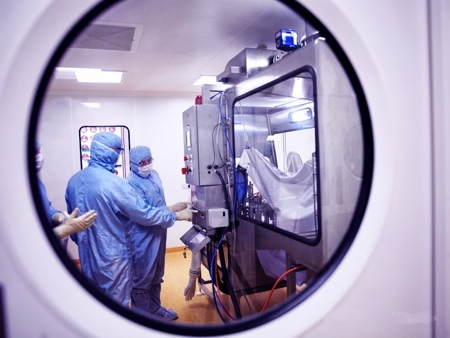
The most effective approach currently deployed to achieve the required degree of containment for HAPI is through the use of partial or totally enclosed barrier systems
Copyright SCM Pharma
An additional challenge occurs for a CMO, where multiple clients’ materials may be held on site for manufacturing campaigns. It is critical to be able to assure that cleaning and isolation of these other materials is properly implemented within accepted GMP conditions to prevent any potential GMP or regulatory issues from developing.
Handling: Controlled and effective segregation of product and personnel in all steps of manufacturing must be implemented, starting with the preparation and compounding processes and ending with cleaning and decontamination following the filling of the drug product. The HVAC systems of the facility have to provide unidirectional airflow for the filling process through HEPA filtration, but the design must also ensure that the filters can be decontaminated after processing. Furthermore, the operator and the environment must be protected from the HAPI during off-line situations, such as maintenance or filter change, which may lead to the release of particles into the immediate manufacturing environment.
One approach is to build a sealed envelope around the critical areas where the active drug is handled and to ensure that manufacturing operations are conducted in the safest possible manner. Simply protecting the personnel with equipment such as dust masks or full air-fed suits alone is not adequate.
The handling of HAPI drugs therefore is built around the principle of protecting drugs and employees from contact with each other, and as little manual intervention as possible. As a result of the strict guidelines from regulators, manufacturers utilise barrier technology such as isolators to reduce human contact with the compounds during manufacturing processes.
Safety Considerations:
- Prior to bringing a new compound in from a drug innovator, the third party manufacturer should assess the toxicity and potency of the API and determine its category or band. This assessment needs to be documented for each API handled and should be conducted by a professional trained or knowledgeable in occupational health, pharmacology, toxicology, medicine or a related field.
- Appropriate PPE must be used, including: airline or powered air purifying respirators with proper cartridges (unless an industrial hygiene monitoring indicates a lower level of protection is acceptable), specifically selected chemical protective clothing and gloves, eye protection and head protection.
- A programme of qualitative and quantitative industrial hygiene exposure assessment needs to be in place, including the use of surrogate monitoring techniques to estimate potential exposures to developmental materials for which no monitoring techniques and exposure limits have been established.
- Appropriate product deactivation or decontamination procedures need to be applied.
- Process hazard reviews are used to integrate appropriate environmental, health and safety activities into manufacturing and R&D operations (e.g. evaluating fire protection and risk management issues, containment and control technology options and waste disposal considerations).
Cleaning Considerations: Handling high potency compounds lends itself in many instances to the use of dedicated or disposable components and single-use components such as process tubing and connectors, product filters, containers and closures. These can aid rapid turnaround between batches and campaigns and reduce the burden of onerous but essential cleaning validation requirements. These may easily be disposed of following manufacture and be an effective tool against cross-contamination efforts and allow significant time savings on product changeovers.
Following manufacture, there is a requirement to demonstrate that residue of the potent material has been removed to an acceptable level and any residue remaining is at a level at or below the Adverse Drug Event (ADE). Acceptance criteria for drug residues on manufacturing equipment after cleaning are based typically on a fraction of the lowest dose (e.g. 1/1000th of the lowest therapeutic dose) for a particular swabbing surface area.
In summary, the product development and manufacture of high potency drug substances and products bring a number of challenges, but not insurmountable obstacles. Technologies to ensure safe handling procedures are widely available (e.g. isolators, split butterfly valves). Formulation strategies for ensuring homogeneity of low dose products are well established and although challenging, the detection of very low levels of drug substances is achievable using the appropriate techniques.


